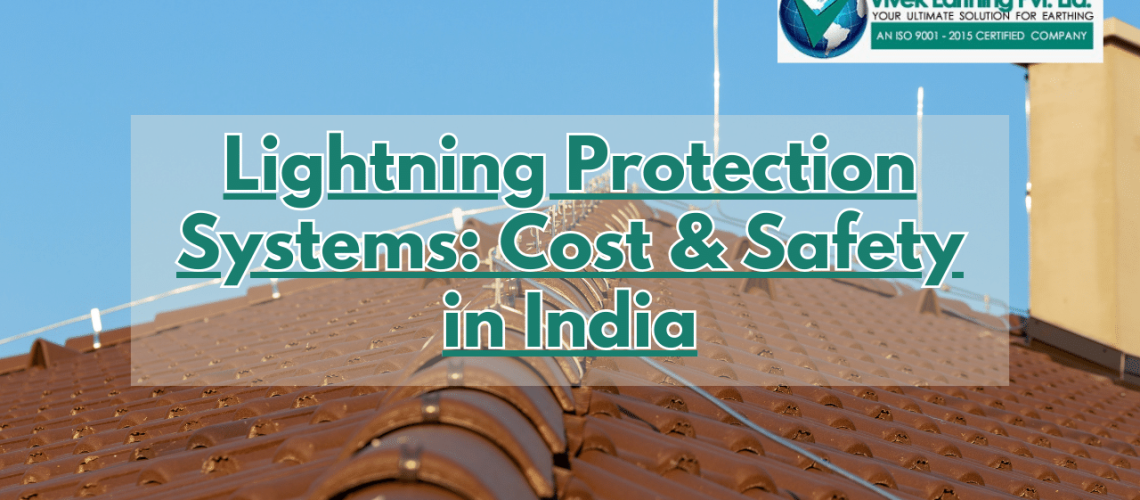Lightning protection systems are essential for safeguarding structures against lightning strikes, a common occurrence in India during the monsoon season. Vivek Earthing is a company that specializes in providing these crucial systems. This article aims to provide comprehensive information about lightning protection systems, with a focus on their pricing in India and an overview of Vivek Earthing’s offerings.

What is a Lightning Protection System?
A lightning protection system is designed to protect buildings from damage caused by lightning strikes. It typically includes air terminals, down conductors, grounding systems, and surge protection devices. These components work together to safely dissipate the electrical charge of lightning into the ground.
Vivek Earthing: A Trusted Name in Lightning Protection
Vivek Earthing is known for its expertise in the field of earthing and lightning protection. The company offers a range of products and services designed to ensure the safety and integrity of structures against lightning damage.
Products and Services
Vivek Earthing’s product lineup likely includes:
- Conventional lightning rods
- Early streamer emission (ESE) systems
- Meshed cage systems
- Grounding materials and accessories
- Surge protection devices
In addition to these products, Vivek Earthing probably offers services such as:
- Site assessment and risk analysis
- Customized system design
- Professional installation
- Maintenance and inspection services
Vivek Earthing is a manufacturer of lightning arresters, earthing electrodes, and earthing plates. Some of their products include:
- Type 4 Copper Lightning Arrester: ₹8,000 per piece
- Ese Lightning Arrester: ₹65,000 per piece
- GI Earthing Spike Arrester: ₹450 per piece
- Earth Discharge Rod: ₹1,500 per piece
- G.I Chemical Earthing Electrode Pipe: ₹550–₹12,300
- Copper Bonded Rod: ₹715–₹1,925
- Earthing Gel: ₹1,700–₹850
Vivek Earthing also offers a brass-coated copper alloy for bonding metallic pipes into the earthing or lightning protection system.
The price for an ESE lightning arrester, including supply and installation, can range from ₹80,000–₹1,50,000. This price can vary depending on the specifications and the type of arrangement selected.
Quality and Compliance
Vivek Earthing likely emphasizes the use of high-quality materials and adherence to national and international safety standards. This ensures that their systems are not only effective but also durable and reliable.
Factors Influencing the Price of Lightning Protection Systems in India
The cost of lightning protection systems in India is influenced by factors such as the type of system, quality of materials, size and complexity of the structure, installation costs, and the brand and manufacturer.
Average Prices in India
Prices for lightning protection systems in India vary, with basic protection starting from around INR 10,000 and going up to several lakhs for advanced systems. Vivek Earthing’s pricing would be competitive within this range, offering value for money through quality and service.
Choosing the Right System with Vivek Earthing
When selecting a lightning protection system, it’s important to consider the specific needs of your structure. Vivek Earthing’s expertise can guide customers in choosing a system that provides adequate protection while fitting within their budget.
Conclusion
Lightning protection systems are a vital investment for safety in India. Vivek Earthing stands as a reputable provider in this field, offering a range of products and services to meet diverse needs. While considering the cost, it’s crucial to prioritize quality and suitability, and Vivek Earthing can be a reliable partner in this endeavour.
FAQs
1. What is a lightning protection system, and how does it work?
Ans. A lightning protection system is designed to protect buildings and structures from damage caused by lightning strikes. It typically consists of air terminals (lightning rods), down conductors, grounding systems, and surge protection devices. These components work together to intercept lightning strikes, safely conduct the electrical charge to the ground, and prevent damage to the structure and its contents.
2. What types of lightning protection systems does Vivek Earthing offer?
Ans. While specific offerings may vary, Vivek Earthing likely provides a range of lightning protection solutions, including conventional rod systems, early streamer emission (ESE) systems, and meshed cage systems. They may also offer grounding materials, surge protection devices, and related accessories. For detailed information on their product range, it’s best to consult Vivek Earthing directly.
3. How much does a lightning protection system cost in India?
Ans. The cost of lightning protection systems in India can vary widely based on factors such as the type of system, quality of materials, size and complexity of the structure, and installation costs. Prices can range from around INR 10,000 for basic systems to several lakhs for more advanced solutions. Vivek Earthing likely offers competitive pricing within this range.
4. How do I know if I need a lightning protection system for my building?
Ans. If your building is located in an area prone to lightning strikes, especially in regions with frequent thunderstorms, it’s advisable to install a lightning protection system. Factors such as the building’s height, location, and the value of the contents inside should also be considered. Consulting with experts like those at Vivek Earthing can help determine the need and the appropriate type of system for your structure.
5. Can Vivek Earthing provide customized lightning protection solutions?
Ans. Most reputable companies in the lightning protection industry, including Vivek Earthing, offer customized solutions based on the specific needs of each structure. This typically involves site assessment, risk analysis, and designing a system that effectively protects the building while considering architectural aesthetics and budget constraints.




One Response
Hello I require lightening protection for my home in Udaipur Rajasthan 313001
please contact me
phone no 9413237445